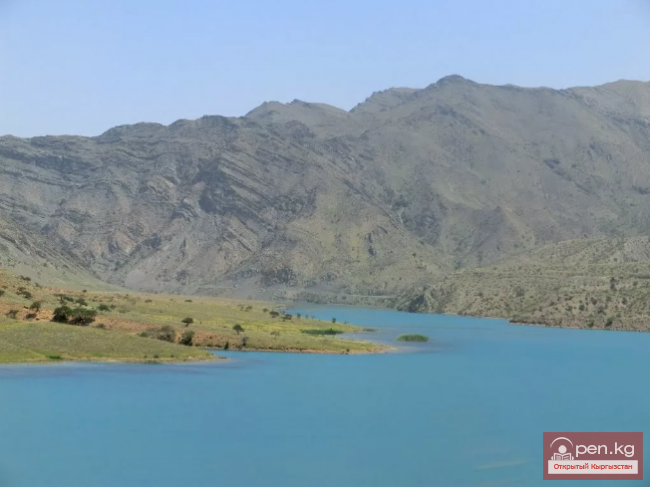Based on materials collected by S. M. Abramzon, R. Ya. Vinnikov, and A. Sydykov (Abramzon, 1960, pp. 3-136; 137-181; Vinnikov, 1957, pp. 71-75; Sydykov, 1992, pp. 111-156), we can judge the settlement of certain tribes. In the late 19th - early 20th centuries, the main mass of the Sarybagysh tribe inhabited the eastern part of the Chui Valley, the territories of Chon-Kemin and Kichi-Kemin, the northern and western parts of Lake Issyk-Kul, the Kochkor Valley, and the areas in the valleys of the Naryn and At-Bashy rivers.
The Bugyns occupied the eastern, northeastern part, and a significant territory of the southern shore of the Issyk-Kul basin. Their pastures also extended into the valley of the Tekes River, located in the territory of the People's Republic of China. The origin of the Tynymseyites is almost always associated with the Bugyn tribe in genealogical traditions. They lived north of the Naryn River up to the On-Archa River, located in the territory of the modern Naryn region. Some clans of the Tynymseyites were also settled in the Pre-Issyk-Kul region, mainly in the modern Jeti-Oguz district.
Large groups of Sayaks lived on the southwestern, northwestern, and western shores of Lake Issyk-Kul, in some areas of the middle course of the Naryn River, in the Jumgal Valley, and in Suusamyr. Small groups of Sayaks were settled in the Chui Valley. Representatives of this tribe also compactly inhabited the territory of the Ketmen-Tyubinsk Valley and the northeastern part of the Bazar-Korgon district.
The Soltins have long inhabited the central and western parts of the Chui Valley. The pastures of this tribe were also located in the adjacent territories of the Kyrgyz Ala-Too range. Their representatives also lived in the neighboring Auliyeatin district of the Syr Darya region.
The Chekir Sayak tribe inhabited the valleys of the Jumgal and Suusamyr rivers in the Central Tien Shan, as well as several areas located in the middle part of the Naryn River. Small groups of them lived in the Chui Valley and in the western part of the Issyk-Kul basin. The high-altitude At-Bashinsky Valley became the habitat of the Cherik tribe.
Representatives of some clans of this tribe, forming a large group, lived in the territory of Xinjiang in neighboring China, while representatives of the Zhediger tribe lived in the present-day Osh region. In the early 20th century, a small group of them was registered in the Pishpek district.
The places of residence of the Aziks included many points in six volosts of the Przhevalsky and Pishpek districts, among which a large group was settled in the Kochkor Valley.
Compact groups of the Bagysh tribe were settled in the valley of the Talas River in the northern part of the region and within the Namangan district of the Fergana region in the south. The Suu Murun tribe, which lived in the Chui Valley, migrated here from the Auliyeatin district of the Syr Darya region in the mid-19th century. The Baaryns inhabited several points in the Talas and Chui valleys.
Groups of representatives of this tribe also lived in Uzgen and Aksy.
Formation of Kyrgyz tribes in various territories of Kyrgyzstan
The Joru, Boru, Kara Bagysh, and Sarttars, which are part of the Adigine branch, lived in the valley of the Gulche River, in the Ak-Buurin, Kashgar-Kishlak, Kurshab, Uzgen, Naukat, and several other volosts of the Osh district in the early 20th century.
Sarttars also lived in compact groups in the Ketmen-Tyubin Valley.
In the second decade of the 20th century, a large group of the Kushchu tribe lived in areas located in the upper reaches of the Talas River, in the western part of the Pishpek district. The main part of the Saruu tribe localized in compact groups in the Beshtash, Kenkol, and Uch-Kurgan volosts of the Auliyeatin district, in the areas of Akсы and Chatkal of the modern Jalal-Abad region.
Most of the Muntuz tribe's descendants lived in the southern territories - Bazar-Kurgan, Aksy, within the Pishpek and Auliyeatin districts. The Kytay tribe was predominantly settled in areas located on the northern slopes of the Talas Ala-Too range and in the western part of the Talas River. Small groups of them were noted in the Pishpek district. The Zhetigen tribe was registered in separate territories of all three districts in the northern part of the country.
The tribes that are part of the Ichkilik union were mainly concentrated in the south. For example, the Kipchaks inhabited groups in the northeastern parts of Batken, Suzak, and Chon-Alai districts. Compact groups of Naymans lived in Chon-Alai, in the western part of the south, and in some other territories. Teiyts and Kesecks occupied the territories of the Alai Valley, individual volosts of the Osh and Jalal-Abad districts. Significant groups of their representatives lived in Tajikistan, Uzbekistan, and China. Representatives of the Teeles tribe lived in compact groups in the central part of the Osh district and in the southeast of Pre-Issyk-Kul.
Some groups were settled dispersively - as inclusions among others. Often, relatives of tribes compactly living in the south could also be found in northern territories. Overall, the clan-tribal composition of the overwhelming majority of administrative-territorial units was heterogeneous.
At a scientific session on the ethnogenesis of the Kyrgyz held in Frunze in 1956, S. M. Abramzon identified several rows of ethnic groups, the names of which reflected important stages in the ethnic history of the people, chronologically covering a long historical period from the 6th to the 19th centuries. Based on ethnographic data, he identified three main components of different origins in the ethnic composition of the Kyrgyz: a) Central Asian, b) Nogai-Kazakh, and c) late West Turkestan elements. Their formation occurred in various territories and at different times (Abramzon, 1959, pp. 36, 37).
Clan-tribal structure of the Kyrgyz

















































